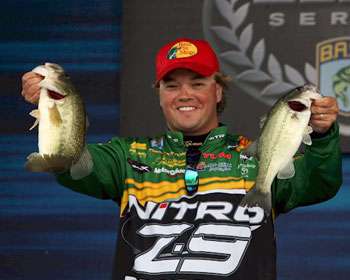
Summer is a time for baseball, family vacations, swimming pools and watermelon. It's the time of year that we see triple-digit temperatures and homemade lemonade stands. But it's not necessarily the favored time of the year for bass fishermen.
Filled with fresh memories of egg-laden bass hauled in during the spring, anglers often dread the onslaught of high temperatures and cloudless skies.
According to Elite Series pro Tim Horton, however, summer can offer some of the most phenomenal bass fishing of any season.
"Fishing can be just amazing this time of year," he says. "Regardless of the season, there are key ingredients that make a significant difference in whether you'll have a successful day on the lake or not. It's likely no truer than in the heat of summer."
This time of year, perhaps the overriding factor is cover. Horton points out that during summer, the best cover is vegetation in any form. "That's the first thing I look for when I plan to fish a lake during the summer," he explains.
"Hydrilla, milfoil, lily pads, water willow and anything else — look for the vegetation that grows the deepest. That's where you'll find the majority of the bass, and more times than not, they will be relating to the deeper cover."
Having chased bass from coast to coast, Horton recognizes that not every lake offers vegetation. In that case, he explains that bass will relate to whatever cover they have available. "If the lakes you are fishing do not have vegetation, then you need to concentrate on the other types of cover available to you," he reveals.
"Bass are cover-oriented predators, so really anything that gives them an ambush point is going to work."
Horton offers that during the summer months, anglers are often faced with the decision to fish deep or shallow cover. Horton's decision to go deep or shallow is determined by water clarity. "If the water has 2 to 3 feet of visibility, then I know I can find bass relating to deep cover," he says.
"On the other hand, if the visibility is a foot or less, I'm going to target any shallow cover available. In dirty water, boat docks are a prime spot for summertime bass."
One of the first things he does when scouting a lake during summer is to locate feeding activity, which usually involves baitfish. "Shad, for example, will usually be limited to the top 10 feet of the water column," he says. "Within that column, there will be a certain depth range where you will see the most activity."
Once he determines the depth range where most feeding activity is occurring, Horton begins looking for cover or structure in the same depth. "The type of cover that I look for depends on the particular body of water," he says. "Here in Alabama, on lakes like Logan Martin and Neely Henry, boats docks are the best types of structure to fish.
"When you move over to the lakes along the Tennessee River, the bass seem to relate more to ledges and points. Bass are adaptive and will relate to whatever cover is most prevalent on that particular lake."
Having found the right cover, Horton reveals that you can further narrow down your fishing area by looking for subtle differences inside that key structure. "I like to target channel swings and small rises along a ledge with a crankbait," he says. "Once I've found the sweet spot, I will go with a slower approach to really try and milk the area."
Originally published August 2009




